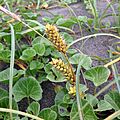Strand sedge facts for kids
Quick facts for kids Strand sedge |
|
|---|---|
 |
|
| Scientific classification | |
| Kingdom: | |
| (unranked): | |
| (unranked): | |
| (unranked): | |
| Order: | |
| Family: | |
| Genus: | |
| Species: |
C. pumila
|
| Binomial name | |
| Carex pumila Thunb. in Murray
|
|
The strand sedge, also known as spreading sedge, is a special type of grass-like plant. Its scientific name is Carex pumila. It belongs to the Cyperaceae family, which includes many different kinds of sedges. This plant is known for growing in sandy areas, especially near the coast.
Contents
What is Strand Sedge?
The strand sedge is a plant that lives for many years. It grows in clumps, looking a bit like a tuft of grass. It can reach a height of about 0.4 metres (1.3 ft), which is less than half a meter tall.
How it Grows
This sedge has a special way of growing. It spreads using long, underground stems called rhizomes. These rhizomes are like hidden roots that creep along, helping the plant spread out. They are about 2 millimetres (0.08 in) thick.
The plant's leaves are a pretty deep blue-green color. They grow in rough clumps. The main stems of the plant, called culms, are often buried in the sand. These stems are round and smooth, usually cream or light green. They are covered by light brown or reddish-brown coverings called sheaths.
The leaves of the strand sedge are longer than its stems, growing up to 40 cm (15.7 in) long. They are about 2 mm (0.08 in) wide. The leaves are stiff and curved, with a channel shape, and they get thinner towards the end.
Flowers and Seeds
Strand sedge plants have both male and female parts on the same plant. In Australia, they usually bloom in the summer, from November to February. They produce small, brown flowers. After flowering, the plant makes seeds. These seeds are oval-shaped nuts, about 2 to 3 mm (0.08 to 0.12 in) long.
Where Strand Sedge Lives
The strand sedge is found in many parts of the world. You can see it in Australia, New Zealand, and Lord Howe Island. It also grows in countries like Chile, China, Japan, and Korea.
Coastal Habitats
This plant loves coastal areas. It is most commonly found on sand dunes, which are hills of sand shaped by the wind. Sometimes, it also grows along the sandy edges of rivers and estuaries near the coast. An estuary is where a river meets the sea.
Australian Locations
In Australia, the strand sedge grows in many temperate coastal regions. This includes areas from Queensland in the east, all the way to Western Australia. It is also found in Tasmania. In Western Australia, it thrives in the sandy soils of the Peel and South West regions.
Sometimes, you might even find it growing as a weed in lawns, especially in towns close to the coast.
Naming the Strand Sedge
The strand sedge was first officially described by a botanist named Carl Peter Thunberg in 1784. He included it in a book called Systema Vegetabilium, which was put together by Johan Andreas Murray.
Sometimes, people mistakenly call another plant, Carex bichenoviana, by the name of Carex pumila. It's important for scientists to use the correct names to avoid confusion!
Images for kids


